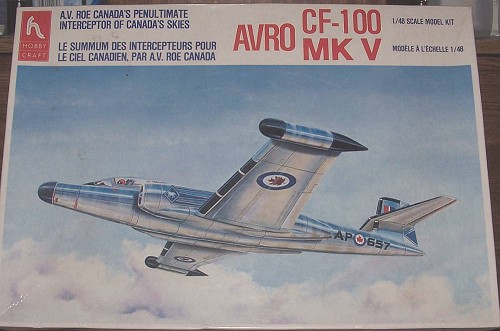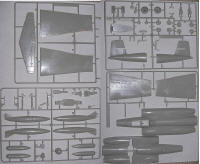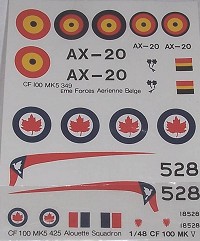
| KIT: | Hobbycraft 1/48 CF-100 Mk 5 |
| KIT #: | HC 1654 |
| PRICE: | $ |
| DECALS: | Two options |
| REVIEWER: | Dimitry Levin |
| NOTES: |

| HISTORY |
The CF-100 was developed as an all-weather interceptor for the Royal
Canadian Air Force. The first prototype took flight on January 19, 1950.
Mk.3 equipped with the same Hughes E-1 fire control system and AN/APG-33
radar as the Northrop F-89A "Scorpion" and armed with 8 0.50 caliber
machine guns in a belly tray entered squadron service in 1953. Mk.4
had up-rated "Orenda" 9 engines, the same Hughes MG-2 collision
course-capable fire control system and AN/APG-40 radar as the F-89D, and 29
2.75" "Mighty Mouse" FFARs in each wingtip pod in addition to machine gun
armament. Mk.5 featured a 3 foot 6 inches straight extension to the wings
and an enlarged tail plane to raise operational ceiling. Upgraded "Orenda"
11 or 14 engines were used and the machine guns were deleted leaving only
wingtip rocket pods.
A total of 693 CF-100 were built. Similar in dimensions and performance to the F-89, the "Clunk" served with distinction with RCAF in Canada and Europe as well as with Belgian AF. It was an honest airplane and very stable in adverse weather conditions where it spent most of its service life.
The biggest complaint levied against it by the pilots was the always cold cockpit. Attempts to modernize the CF-100 were abandoned in favor of the promising CF-105 "Arrow" and the aircraft was eventually replaced in RCAF frontline service by the mighty CF-101 "Voodoo." The last of the "Clunks" was retired in 1981.
| THE KIT |
 In
spite of being the only all-Canadian jet fighter to reach production and
arguably the best all-weather interceptor on the 1950's with a 30-year
service life, the CF-100 is grossly under-represented in styrene.
Hobbycraft is the only game in town, making Mk.4 and Mk.5 in both 1/72 and
1/48 scales. The 1/48 Mk.4 is essentially the same kit as the Mk.5
reviewed here with the correct short wings, small tail plane, and an added
machine gun belly pack. Mk.4 specifics such as the gun sight are not
included.
In
spite of being the only all-Canadian jet fighter to reach production and
arguably the best all-weather interceptor on the 1950's with a 30-year
service life, the CF-100 is grossly under-represented in styrene.
Hobbycraft is the only game in town, making Mk.4 and Mk.5 in both 1/72 and
1/48 scales. The 1/48 Mk.4 is essentially the same kit as the Mk.5
reviewed here with the correct short wings, small tail plane, and an added
machine gun belly pack. Mk.4 specifics such as the gun sight are not
included.
Upon opening a gigantic box (double the size of Monogram's Century
aircraft!) one finds a lot of empty space and 50 parts cleanly molded in
light gray styrene. The overall accuracy is quite good. The recessed
panel lines are somewhat broad and deep but consistent and sharp. A coat
of thick primer should bring these in line with most modern kits. Cockpit
consists of a tub, front and rear instrument panels, pedals and stick for
the pilot, and a clear windscreen for the RIO. Ejection seats are four
parts each and are fair, if simplified, representations of the real
things. Detail on the instrument and side panels is simplified and
occasionally fictional but probably adequate if the canopy is left closed
as the cockpit is deep, narrow, and painted black like all British and
Canadian aircraft of the time.
Adding accurate detail may be
difficult because the CF-100 references are scarce. The kit also includes
two very nice seated pilot figures that would not be out of place in
a Monogram kit. Fuselage is made up of five parts, these being main
fuselage and engine pods, split top and bottom, tail section split left and
right, and a nose cap. Modeler is advised to add 20-30 grams of weight to
the nose. The expansive wings attach to the fuselage via two small tabs in
what is essentially a butt join. Fortunately, the mating area is
quite large and I don't anticipate strength problems. Sticklers for
accuracy should note that flaps are molded in the raised position while
they droop on most parked CF-100's. Liberating the flaps should not be too
difficult thanks to the deep panel lines although the multi-curved fuselage
flap may take some bravery. Engines are represented with plugs in front
and back of the nacelles. The front plugs have shallow compressor face
detail but are appropriately deep and have the proper slant when viewed
from the side. The rear plugs are deep but have no detail. Landing gear
bays are deep but lack all detail. Landing gear is remarkably sturdy, just
like on the real thing. It lacks all but the major detail but is accurate
in shape and geometry. Real CF-100 gear was not exceptionally elaborate
and even basic detailing would go a long way on this model. In contrast,
wheels have nice hub detail. Landing gear doors are very thick and sanding
them down would carry the added benefit of removing obviously fictional
detail from the inside surfaces. The one-piece canopy is thin and clear.
The kit includes both wingtip rocket packs and fuel tanks. Dry-fitting of
major parts showed very good fit and no warping.
 The box art advertises
decals for CF-100 Mk.5 from 413th "Tusker" squadron which is different from
the contents of the box. I attributed this discrepancy to eBay until I
noticed that the front page of the instructions showed the same "Tusker"
aircraft while the painting instructions on the back matched the included
decals. So your guess is as good as mine. Two options are included, both
CF-100 Mk.5's.
The box art advertises
decals for CF-100 Mk.5 from 413th "Tusker" squadron which is different from
the contents of the box. I attributed this discrepancy to eBay until I
noticed that the front page of the instructions showed the same "Tusker"
aircraft while the painting instructions on the back matched the included
decals. So your guess is as good as mine. Two options are included, both
CF-100 Mk.5's.
1. 425th "Alouette" Squadron RCAF in bare aluminum with a red "swoosh"
stripe on engine nacelles.
2. 349eme Belgian Aerial Escadrille Squadron in standard Dark Sea Gray /
Dark Green over Medium Sea Gray camouflage.
Decals are thin and appear well-printed but the black centers on Belgian
roundels are slightly offset.
Instructions show construction in 10 steps, more than adequate for this
simple model. No colors are indicated during construction. Painting
instructions give left, right, and top views for both schemes. Colors are
provided as both generic names and FS numbers.
| CONCLUSIONS |
While the Hobbycraft CF-100 lacks the detail of the Monogram kits, it
should build into a very nice representation of this significant aircraft.
As a huge fan of early jets, I am looking forward to adding this 20-ton
monster to my flight line of Monogram's Century aircraft. The kit is not
terribly common but can be found at a very reasonable price.
Editor's Note: There was a very nice Canadian Profile #3 on the CF-100. Though probably out of print, it is a good reference on the type.
October 2005
If you would like your product reviewed fairly and quickly by a site that has around 300,000 visitors a month, please contact me or see other details in the Note to Contributors.